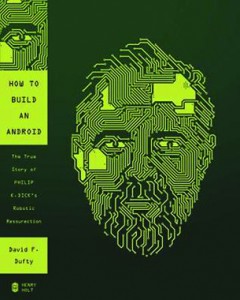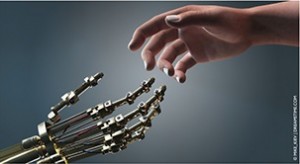How to Build an Android: The True Story of Philip K. Dick’s Robotic Resurrection

In the eighteenth and nineteenth centuries the elites of Europe and the United States were thrilled by what they perceived as a rather sophisticated class of automatons, mechanical marvels that could do everything from play music to draw to defecate. (The subject is amusingly scrutinized in Tom Standage’s The Turk.) How quaint those erstwhile days now seem! As David F. Dufty’s nifty How to Build an Android makes clear, automatons have come a long, long way from the era of defecating duck contraptions.
In 2003, respected computer scientist Art Graesser, who was the head of the Institute for Intelligent Systems at the University of Memphis, and a masterful academic bureaucrat (he was adept at obtaining grants), heard a talk on robotics by a Dallas graduate student named David Hanson. “It was…clear from his talk that Hanson could see the big picture. He mused about the changing relationship between humans and machines and what the future held for a society populated by increasingly intelligent machines. He explained how advances in technology meant we needed new ways of studying the way humans and machines were coevolving.” Hanson was trained as a sculptor and the robots he built were considered aesthetic as well as technological achievements: “He showed a series of photographs of his work in Dallas. … It was clear that Hanson was dynamic, intelligent, and creative. Not only that, his robot was beautiful.”
Graesser and Hanson met after the talk and hit it off. In 2004 Graesser arranged for Hanson to visit the University of Memphis, where he was introduced to Andrew Olney, a fellow graduate student and software wiz. The two of them decided to collaborate, and Hanson pitched an idea that Olney enthusiastically embraced: construct an android (“a robot whose specific purpose is to look and behave like a human being”) that was a duplicate of the celebrated science fiction writer, Philip K. Dick (author of Do Androids Dream of Electric Sheep?, The Man in the High Castle, A Scanner Darkly, forty-five other novels, and a great many short stories).
Why Dick? For one thing, both Hanson and Olney adored his work. For another, Dufty explains, it seemed relevant to them that Dick “loved androids, but he was also afraid of them. Though none were built during his lifetime [1928-1982], they filled his head and populated his stories. That androids would one day walk the Earth, he was sure, but he grappled with their nature. Would they be good or evil? Would they think they were humans? Would they take over the world? Would they be the next step in evolution?”
Soon after Hanson and Olney talked, Hanson met in New York City with Chris Anderson, the editor of Wired magazine, and some of Anderson’s colleagues. The Wired cadre was so excited by Hanson’s description of the prospective “Phil” that they persuaded him to commit to showing the robot in Chicago the following year, at Wired’s glitzy annual NextFest technology expo. Now all Hanson, Olney, and their associates had to do was build the thing. Specifically, they planned to construct an android head that would be attached to an inert mannequin clothed in Dick’s actual attire. The back of the head would be left uncovered, exposing internal machinery. “It was a statement about the whole project,” Dufty writes of their plan, “the dual human-machine nature of the android, and the blurred boundaries between human and machine.” On a less postmodernist, more pragmatic level, leaving the back of the skull open would save a lot of time in the building of Phil. They had approximately one year to pull it off.
Most of How to Build an Android is an account of how Hanson and Olney turned their wildly ambitious dream into a robot that was a spookily true-to-life incarnation of Philip K. Dick. (“Hanson didn’t want to make a mere talking machine. He wanted to make something that would really seem to be alive.”) Hanson was the “hardware” specialist, responsible for crafting Phil’s appearance and the motors that would control his lifelike facial movements. From technology companies that offered their services pro bono (Art Graesser’s fund-raising prowess failed him on this project), Hanson procured a first-rate plastic skull and machine parts. For skin, he used an invention of his own design (which he had patented) called Frubber.
The assignment confronting Olney, the software virtuoso, was particularly daunting. He wanted Phil to be able to respond to interlocutors’ questions without (for the most part) resorting to preprogrammed responses; he wanted, in other words, “to create a model of Dick’s mental world.” Olney turned to a methodology called latent semantic technology (LSA), “a way of capturing the semantic content of a word by looking at the range of contexts the word tends to get used in. It is a way for machines to understand meaning. The basic method behind LSA is to first put together a large collection of documents.” That last point required that Olney process into Phil’s software virtually every book Dick had ever written as well as a multitude of transcripts of interviews with the writer. The android also had to be programmed with speech-recognition, facial-recognition, and facial-tracking systems. Phil packed a lot of goodies. (I feel compelled at this point to acknowledge the invaluable contribution provided to Olney by Billy Bass, the singing fish—you’ll have to read the book.)
 How to Build an Android is surprisingly suspenseful: Will the roboticists meet their deadlines? Will Dick’s daughters consent to Olney and Hanson using their father’s intellectual property? Will the completed Phil perform to expectations? I won’t play the spoiler here. What I can mention—because it received a lot of media attention at the time—is that in December 2005 a sleep-deprived David Hanson lost Phil’s head while they were flying between Dallas and Las Vegas. The robot was never recovered. Was Phil the victim of the airline’s bureaucratic inefficiency? Was the android stolen? To this day, no one knows. (I’m not, as the book makes clear, the only one with an image in his mind of Phil making a dash for freedom by hopping off like a frenetic Bugs Bunny.)
How to Build an Android is surprisingly suspenseful: Will the roboticists meet their deadlines? Will Dick’s daughters consent to Olney and Hanson using their father’s intellectual property? Will the completed Phil perform to expectations? I won’t play the spoiler here. What I can mention—because it received a lot of media attention at the time—is that in December 2005 a sleep-deprived David Hanson lost Phil’s head while they were flying between Dallas and Las Vegas. The robot was never recovered. Was Phil the victim of the airline’s bureaucratic inefficiency? Was the android stolen? To this day, no one knows. (I’m not, as the book makes clear, the only one with an image in his mind of Phil making a dash for freedom by hopping off like a frenetic Bugs Bunny.)
How to Build an Android could use an index, and its author is, I think, a bit too credulously enamored of Google. I must also admit that the book hasn’t persuaded me to read Philip K. Dick. (His oeuvre is apparently suffused with paranoia, and my life already instills enough paranoia into my beleaguered psyche, thank you very much.) These are, however, minor quibbles. This is, I believe, David Dufty’s first book, and he can be proud of what he’s accomplished. The book is readable and engrossing, and the technology details are deftly clarified. Dufty, an Australian with a Ph.D. in psychology, was doing postdoctoral research at the University of Memphis when the events he reports on took place. Though he didn’t work on Phil, Dufty’s sideline observations of the robot’s creation enrich the narrative. He also discusses the philosophical issues that inevitably arise from a book like this—the “are-robots-becoming-more-human-and-if-so-what-are-the-implications?” conundrums—sensibly and tactfully. The author’s consideration of the Uncanny Valley theory (much pondered by roboticists) is especially suggestive: “When machines become very lifelike … the positive experience [felt by humans toward robots] would break down and be replaced by a negative emotion.”
At some point during my journey through adulthood, I started wishing I could be a scientist. It didn’t matter what kind—botanist, physicist, whatever. I thought that scientists did great things and would shape the future of humanity. But reading How to Build an Android, I have to say, has given me pause. Because for me, the book’s subtext isn’t so much how robots are becoming more human, but how scientists are becoming more brilliant—and thus more intellectually estranged from the rest of the human race.
